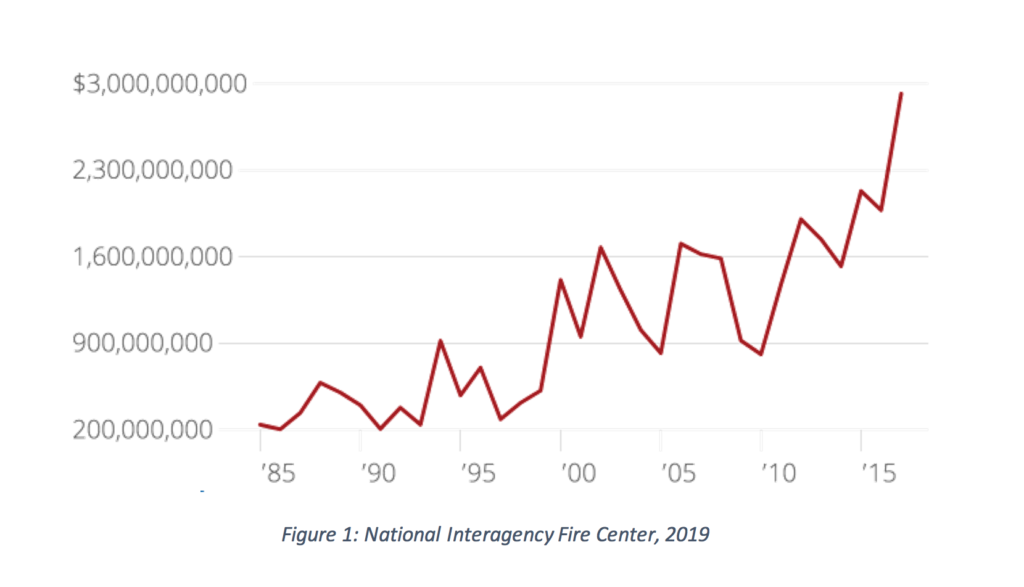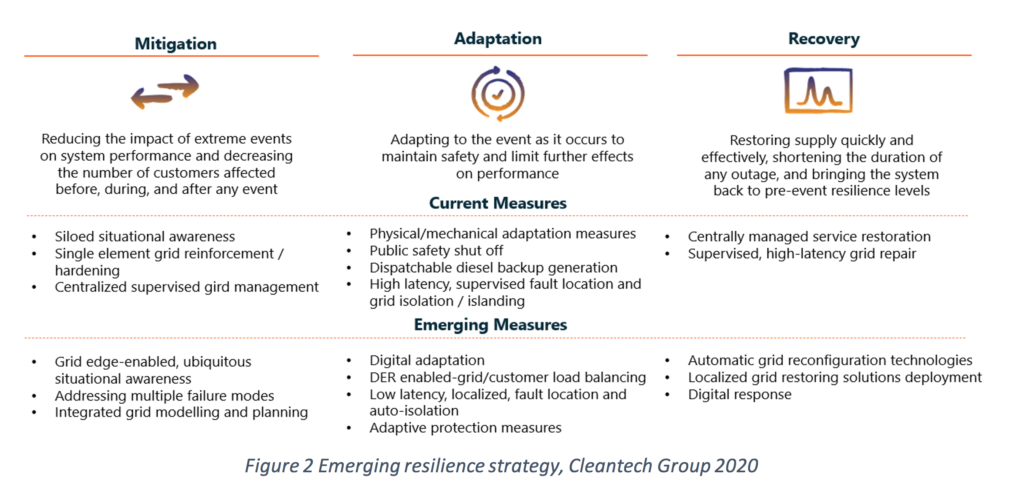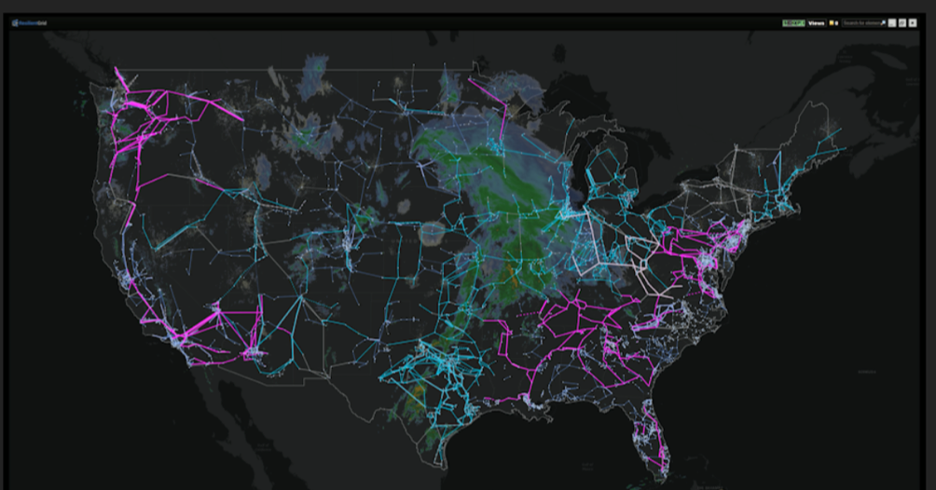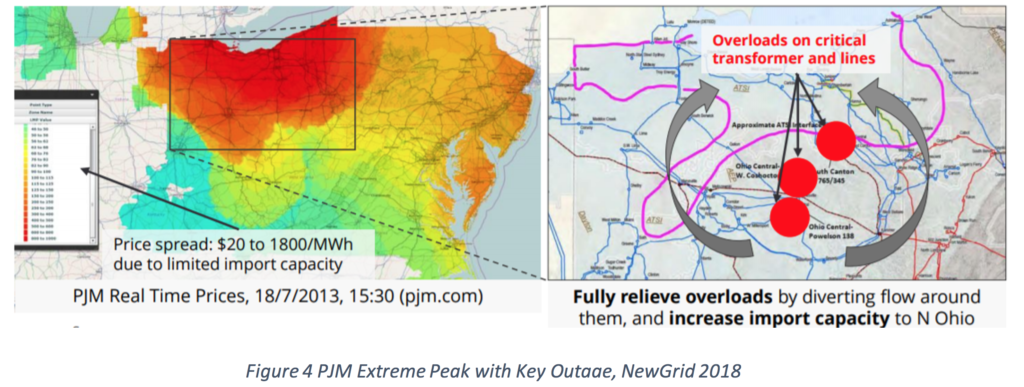Digital Smart Grid Resilience: Wildfire Mitigation and Reliability
Wildfires are getting worse. This summer, the West Coast of the United States has once again been the hardest hit, with 2020 projected to be California’s worst wildfire season to date. Given the extent of fires in three of the last four years, wildfires are now expected to cause more than $10 billion worth of damage. Let alone the huge impact on human life, the impact and frequency of these fires have harmed the economy at an alarming rate (See Figure 1, below).

Resilience, defined as “the ability to reduce the magnitude and/or duration of disruptive events,” is becoming a vital component of grid operation, as a convergence of influencing factors increases the risk of power outages and additional system strain.
Aside from the risk of wildfires, there are several main factors making traditional grids inadequate and redundant, thus hardening strategies in place today. These reasons include:
- An increased adoption of renewables
- The distribution of energy resources
- Increased electricity demand
This confluence of factors, alongside the additional layer of uncertainly caused by COVID, is driving grid operators to reimagine how grids are developed, operated and managed. Operators are rethinking their grids and combining system reliability and resiliency with digitization at their core. As a result, operators are beginning to proactively mitigate disaster risk rather than just manage recovery.
Innovation in the how data is accessed, processed, managed,and acted upon is enabling new demands for low latency communication, automation, decentralized analytics and control. Data is projected to play a core role in how operators maintain system reliability, mitigate the impact of natural weather events (by adapting as the event occurs) and restore supply.

Resilience Today
Today, grid operators already prioritize reliability using traditional grid hardening. However, CAPEX heavy upgrades and restoration is proving inadequate. Pacific Gas & Electric (PG&E) was responsible for 1,500 fires in California between 2014 – 2019 due to equipment ignition. Following the 2018 wildfires, the company was fined $25.5 billion on top of $13.5 billion for personal loss, resulting in bankruptcy in January 2019. In July 2020, the utility remerged, supported by $58 billion, to fundamentally reinvent themselves. Outside of the public safety power shutoffs, PG&E is making use of digitally enabled innovations including enhanced vegetation management, situational awareness, and digital control.
Emerging Resilience
Companies on the wildfire frontlines have been forced to adopt innovation, but the trend is reflective of a broader shift towards proactive strategies based on mitigating disaster risk rather than emphasizing disaster recovery. Emerging grid architectures look to mitigate the risks of wildfires and enhance system reliability.
 Figure 2 (above) demonstrates how system mitigation, adoption and recovery is changing.
Figure 2 (above) demonstrates how system mitigation, adoption and recovery is changing.
Emerging Business Models
Today’s grid systems rely on centralized control, asset specific situational awareness and siloed data architecture. Emerging technologies and business models are looking to enable systems based on:
- Hierarchical layered control
- Sub-second latency communication
- Ubiquitous situational awareness
- Interoperable data architecture
Grid Sensors
Across grids, sensors are an important enabling technology, allowing for timely diagnosis, prediction, and prescription of all system variables and assets during normal and extreme-event conditions. Despite wide deployment of SCADA systems and the uptake of advanced metering infrastructure, the lack of low-cost and ultra-low-latency options means most transmission and distribution grids remain blind beyond distribution substations. Two major pathways are being taken by innovators today:
- Ultra-low cost: Innovators are using basic components, outsourcing manufacturing and using non-contact wide area networks to provide visibility across large volumes of line miles. Awesense sensors, for example, are priced at $99, having dropped by factor of 10. Norway-based innovator Heimdall Power raised $3.9 million equity funding in August 2020 for their low-cost, self-powered, on-line sensor which measures temperature, inclination, and power.
- Ultra-low latency: Innovators are developing sensors to measure time-synchronized phasors and are also inventing sensors to enable sub-second dynamic line rating. Synaptec for example, has developed optical electro-mechanical sensors to passively measure voltage and current at any location on a power system.
Grid Data and Analytics
Using traditional measures, a manual or centralized approach is taken for grid data collection, processing, and risk mitigation planning. In addition, implementation is schedule-based and often siloed to individual grid assets. Over the last decade, opportunity analytics has grown due to the increase in availability of data and sophistication of AI, which can be used for predictive planning, maintenance, and verification processes, thus reducing risk of fire and outages.
Innovators in the market today offer SaaS packages focused on different grid applications, or offer integrated offerings with sensors and communication included, including:
- Vegetation Analytics: Using AI to manage vegetation for utilities, reducing fire risk and power outages. Innovators include LiveEO and Overstory, who raised $1.7 million seed in September, using AI and geospatial analytics to manage vegetation for utilities.
- Powerline Analytics: Building on the raw data provided by sensors, innovators provide insights on powerline systems, including innovators Buzz Solutions and PingThings.
- Grid Asset Analytics: Innovators create a grid’s digital twin for operational analytics, emergency management and communication. Innovators can be resiliency focused such as Resilient Grid, or operation/reliability focused, such as Future Grid.
Planning and Design

Innovator such as Envelio use analytics to build and plan the grid to upgrade its infrastructure to prevent failure, plus they can plan for non-wire alternatives.
Digital Grid Control
Traditional rigid mechanical control is proving to be ineffective for integrating volatile power, variable frequencies and increased system complexity. If countries transition using traditional grid architecture, power outages will increase and so will costs.
Digital control incorporates data to optimize flexible, complex energy networks which are evolving from today’s linear systems. Centrally managed, these distribution management systems manage core grid functions including self-healing grids and voltage optimization but are limited by the latency of control response.
Innovators are now offering localized and edge-control, enabling sub-second grid control, increasing system stability, power quality and grid resilience:
- Turnkey optimization systems: Edge-computing innovators are incorporating sensors, communications and hardware, focussing on low optimizing voltage across distribution lines. DEPSys and Zaphiro Technologies are two European players looking to expand globally.
- Power Flow Control: Innovators are using power electronics and software both for voltage correction/redirection during outages and to increase grid capacity. Innovators include Volt/VAR optimization players Varentec and Switched Source and on-line modular power flow control innovatorLast year, Smart Wires signed a 5-year agreement with UK grid operator National Grid ESO to increase network capacity by 1.5GW to enable greater volumes of renewable power.
- Synthetic Inertia: Power harmonics issues on the grid are created from the combination of non-linear devices from customers and inverter-based renewable generation. Distortion from grid harmonics today is addressed using mechanical filters and equipment standards, but as adoption of non-linear devices continues to grow, the potential for grid damage and outages rises. Digital synthetic inertia is an early-stage idea which Synvertec is developing. The idea ensures control
algorithms emulate mechanical and electrical properties of a synchronous generator.

- Topology Optimization: Software can automatically identify grid reconfigurations to route power around congested transmission facilities, helping to facilitate the planning of outages and allowing grids to quickly adapt, which can prevent (or minimize) customer disconnect and expedite grid recovery. An early market innovator NewGrid has a number of pilots underway. The figure above (Figure 4) demonstrates an example of grid reconfigurations.
Adoption Hurdles Ahead
No silver bullet exists when it comes to solving the grid resilience challenge. It remains impossible to accurately predict the long-term impact natural events will continue to have on the grid. In addition to this, the scale of each innovation’s impact depends largely on a range of factors including geography, regulation and the age of grid infrastructure.
Unfortunately, despite the array of opportunities to build digital resilience, the conservative nature of the utility market has largely limited the ability for new technologies to make it past the pilot stage.
Innovators around the world are patiently waiting for 100% digital system plans to be implemented before they see wide-scale demand. Furthermore, the pace at which utilities set renewable targets ultimately sets the demand cap for some of the newer, more expensive grid optimization offerings coming to maturity, which tend to be in areas less prone to outages caused by natural events.
Keep an Eye On
- Solid state grid hardware replacing existing mechanical systems. Technology remains expensive today, but innovators including Atom Power are bringing solutions to mass market.
- Switching over to DC-based power systems on low voltage grids. Although an expensive infrastructure option, the efficiency advantages of DC-based control may soon outweigh the costs. Innovators Arda Power, Ferroamp and Nextek are all worth watching.
- Grid-connected microgrids and their associated innovative financing models are already starting to make an impact. Innovators are differentiating on the control level, looking to provide revenue opportunities for asset owners when traditional grid services are out of reach. Innovus Power and SwitchDin are worth watching.


